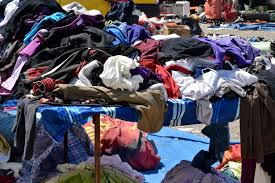Slowing Down the Fashion Industry

Here is a photo of clothing waste. Every year, almost 11 million tons of clothes are thrown away in the U.S. Photo from Pixnio.com
In a fast-moving world filled with constant innovation and migration, we settle for accessibility. Part of this rapidly-moving world is the demise of the fashion industry: fast fashion. In simple terms, fast fashion is cheap, and typically, trendy attire that is produced at a rapid-fire pace in order to keep up with trends. In our world, being “trendy” is a must to have any influence on social media or amongst peers. However, trendiness becomes lackluster when you delve into why fast fashion is not only horrible for the environment, but also the low-paid workers making the items.
Fast fashion originated as a way to keep up with the demand for trends. The beginning of fast fashion started with the Industrial Revolution where innovation in manufacturing and production emerged. There was also a higher demand for slaves in textile factories which allowed for cheap labor.
Almost 250 years later, in the early 2000s, the fashion industry began to boom. However, the price tag seen on clothing walked on the runway was far too steep of value to the regular middle-class person. The solution? Brands such as Forever 21 and Shein began to take inspiration from luxurious runway fashion but sold the items at inexpensive costs. At first, this appeared to be revolutionary. Being able to wear almost the same clothes, for example, Paris Hilton (an early 2000s queen), for more than 1/2 the price seemed like a dream. But what many did not know is that it was a nightmare in disguise.
One of the most detrimental impacts of fast fashion is its damage to the environment. Currently, our environment and climate are undergoing immense changes due to the increase in the use of fossil fuels. A somewhat unexpected, but key contributor to this has been fast fashion brands such as Zara, Charlotte Russe, H&M, Forever 21, etc. For example, almost all fast fashion brands utilize cheap fabrics such as polyester and cotton. Both, however, contain toxic chemicals and dangerous dyes that can get into water sources and affect the animal and human populations of that area. Polyester also contains microfibres, a contributor to the massive levels of plastic in the oceans and. Besides this, almost 11 million tons of clothes are thrown away in the US each year, increasing landfill waste.
The threat towards garment workers has also been recognized as another reason why the fashion industry needs to “slow down.” Following the 2013 collapse of the Rana Plaza clothing manufacturing factory in Bangladesh that killed 1,000 workers, many began to take a stronger appeal to sustainable and slow fashion. Besides the lack of care for the workers, many are also exposed to dangerous toxins, such as lead, which can cause a higher risk of infertility, heart attacks, etc. Workers are also put at risk from the extremely long hours, the low-pay wages, and sometimes even physical abuse. As journalist and author Lucy Siegle stated, “fast fashion isn’t free. Someone somewhere is paying.”
Despite the stronghold of the fast fashion industry, the sustainable world of fashion is growing. To keep up with the trend of a more sustainable world, there are a few things you can do. Before shopping always research the brands you’re purchasing from. Many brands may have a history of not paying their workers or utilizing harmful chemicals in their merchandise. You can also shop second-hand, meaning shopping at thrift stores and online thrift accounts, which can be found on Instagram, Mercari, Courtesy, Depop, Poshmark, etc. This prevents clothes from going to waste. If everyone consistently does these simple steps, the fast fashion industry will soon see it’s demise, and the sustainable fashion industry will continue to be on the rise contributing to a more sustainable, and ethical world.
Your donation will support the student journalists of Parkland High School. Your contribution will allow us to purchase equipment and cover our annual website hosting and printing costs.






